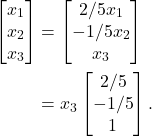Problem 134: Find the basis for the null space of
(1) 
Solution: In order to find the null space of the given matrix, we first need to make the matrix in row reduced echelon form. That is, when we row reduced the matrix ![]() , we get the following matrix
, we get the following matrix
(2) 
Since we are looking for the null space, we have
(3) 
Multiplying the matrices we get
(4) ![]()
Note that we are solving the pivot columns in term of the free variable. Thus
(5) 
What does this mean? This means that basis for the null space if given by
(6) 

Leave a Reply